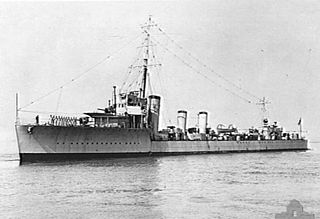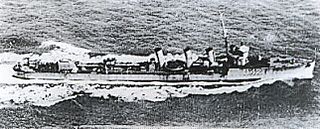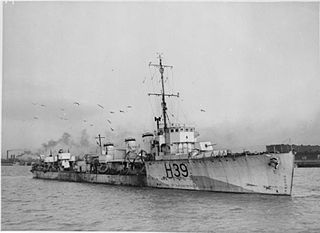
The Arethusa-class cruisers were a class of eight oil-fired light cruisers of the Royal Navy all ordered in September 1912, primarily for service in the North Sea. They had three funnels with the middle one somewhat larger in diameter than the others. All served in the First World War. They were found to be very cramped internally.

The V and W class was an amalgam of six similar classes of destroyer built for the Royal Navy under the 9th, 10th, 13th and 14th of fourteen War Programmes during the First World War and generally treated as one class. For their time they were among the most powerful and advanced ships of their type in the world, and set the trend for future British designs.

The Parker-class leaders or improved Marksman-class leaders were a class of six destroyer leaders built for the Royal Navy during 1916–17 for World War I service. They were named after famed historical naval leaders, except for Anzac, which was named to honour the Australian and New Zealand Army Corps, and was later transferred to the Royal Australian Navy. They were the last major Royal Navy warships to be ordered with three propeller shafts, a design that was never widely adopted in British warships.

The M class, more properly known as the Admiralty M class, were a class of 85 destroyers built for the Royal Navy that saw service during World War I. All ships were built to an identical – Admiralty – design, hence the class name. 18 other vessels which were officially included within the 'M' class were built to variant designs by three specialist builders – 10 by Yarrow, 6 by Thornycroft, and 2 by Hawthorn Leslie; these are covered in other articles.
The Yarrow Later M class were a class of seven destroyers built for the Royal Navy that saw service during World War I. They were based on the preceding and successful Yarrow M class with minor alterations; notably reduced beam to compensate for increased displacement and a sloping stern. They were sometimes described as the Yarrow R class of destroyers.

The Thornycroft M or Mastiff class were a class of six British destroyers completed for the Royal Navy during 1914–16 for World War I service. They were quite different from the Admiralty-designed ships of the Admiralty M class, although based on a basic sketch layout provided by the Admiralty from which J I Thornycroft developed their own design. Like the 'standard' Admiralty M class they had 3 funnels, but the centre funnel was thicker in the Thornycroft ships. The midships 4 in gun was shipped between the 2nd and 3rd funnels. Patriot was fitted to carry a kite balloon.

The A class as designated in 1913 was a heterogeneous group of torpedo boat destroyers (TBDs) built for the Royal Navy in the mid-1890s. Some 42 vessels were constructed to the individual designs of their builders to meet Admiralty specifications, the only uniting feature being a specified top speed of 27 knots (50 km/h). In fact the initial six vessels were generally differentiated by a slightly lower speed and were often referred to as "26-knotters" to distinguish them from the following batch of thirty-six vessels; all fifteen surviving "27-knotter" vessels were classified by the Admiralty as the A class in 1913 to provide some system to the naming of HM destroyers. All of the "26-knotters" and most of the "27-knotters" had been lost or scrapped before the 1913 classification, but for convenience all 42 ships are listed below. The number of funnels varied from one to four. All vessels had a distinctive "turtleback" forecastle that was intended to clear water from the bow, but actually tended to dig the bow in to anything of a sea, resulting in a very wet conning position.

The first R class were a class of 62 destroyers built between 1916 and 1917 for the Royal Navy. They were an improvement, specifically in the area of fuel economy, of the earlier Admiralty M-class destroyers. The most important difference was that the Admiralty R class had two shafts and geared turbines, compared with the three shafts and direct turbines of the Admiralty M class, but in appearance the R class could be distinguished from its predecessors by having the after 4-inch gun mounted in a bandstand. The Admiralty ordered the first two of this class of ships in May 1915. Another seventeen were ordered in July 1915, a further eight in December 1915, and a final twenty-three in March 1916.

The Marksman class were a class of flotilla leaders built for the Royal Navy. Two each were ordered in the naval programmes of 1913–14 and 1914–15 with a further three being ordered under the Emergency War Programme and all saw service during World War I.

HMS Welland was a Yarrow-built River-class destroyer ordered by the Royal Navy under the 1902 – 1903 Naval Estimates. Named after the River Welland that drains into the Wash on the English east coast, she was the first ship to carry this name in the Royal Navy.

HMS Ribble was a Yarrow-type River-class destroyer ordered by the Royal Navy under the 1901 – 1902 Naval Estimates. Named after the River Ribble in northern England, she was the first ship to carry this name in the Royal Navy.

HMS Teviot was a Yarrow type River Class Destroyer ordered by the Royal Navy under the 1902 – 1903 Naval Estimates. Named after the River Teviot in southern Scotland near the border with England, she was the first ship to carry this name in the Royal Navy. She served during World War 1, primarily on anti-submarine duty in the Channel, and was sold for breaking up in 1919.

HMS Usk was a Yarrow type River Class destroyer ordered by the Royal Navy under the 1901 – 1902 Naval Estimates. Named after the River Usk in Wales flowing through Newport, she was the first ship to carry this name in the Royal Navy.
HMS Garry was a Yarrow-type River-class destroyer of the Royal Navy built under the 1903 – 1904 Naval Estimates. Named after the River Garry in north central Scotland, she was the first ship to carry this name in the Royal Navy.
HMS Laverock was a Laforey-class destroyer of the Royal Navy. She was launched in 1913 and entered service in October 1914. Laverock served through the First World War, operating with the Harwich Force and in the English Channel. She was sold for scrap in 1921.
HMS Lark was a Laforey-class destroyer of the British Royal Navy. The Laforey class was the class of destroyers ordered under the Royal Navy's 1912–1913 construction programme, which were armed with three 4-inch (102 mm) guns and four torpedo tubes and were capable of 29 knots. The ship, which was originally to be named Haughty but was renamed before launch, was built by the Scottish shipbuilder Yarrow between 1912 and 1913.

HMS Sorceress was an R-class destroyer which served with the Royal Navy during World War I. Launched on 29 August 1916, the vessel operated as part of the Grand Fleet until it was disbanded in 1919. The destroyer was sold to be broken up on 29 April 1927.

HMS Linnet was a Laforey-class destroyer that served with the Royal Navy during the First World War. Launched on 16 August 1913 as HMS Havock, the ship was renamed on 30 September under an Admiralty order to become one of the first destroyers in a class named alphabetically. This convention subsequently became the norm. On commissioning, the vessel joined the Third Destroyer Flotilla and operated as part of the Harwich Force. The destroyer was first commanded by Commander Loftus Jones who named his daughter Linnette after the ship. During the War, the destroyer took part in the Battle of Heligoland Bight in 1914, and escorted minelayers on missions to lay mines. It was during one the latter missions that the ship was nearly hit by a gun hurled from the stricken minelayer Amphion. With the cessation of hostilities, the ship was placed in reserve and sold to be broken up on 4 November 1921.

HMS Mounsey was a Yarrow M-class destroyer of the British Royal Navy. Built by the Scottish shipbuilder Yarrow in 1914–1915, Mounsey served in the Grand Fleet during the First World War, and took part in the Battle of Jutland. The following year she saw combat against German submarines, and in 1918 she helped rescue crew and passengers aboard the damaged troopship Otranto. She was sold for scrap in 1921.

HMS Lawford was a Laforey-class destroyer of the British Royal Navy. The Laforey class was the class of destroyers ordered under the Royal Navy's 1912–1913 construction programme, which were armed with three 4-inch (102 mm) guns and four torpedo tubes and were capable of 29 knots. The ship, which was originally to be named Ivanhoe but was renamed before launch, was built by the Scottish shipbuilder Fairfields between 1912 and 1914.















